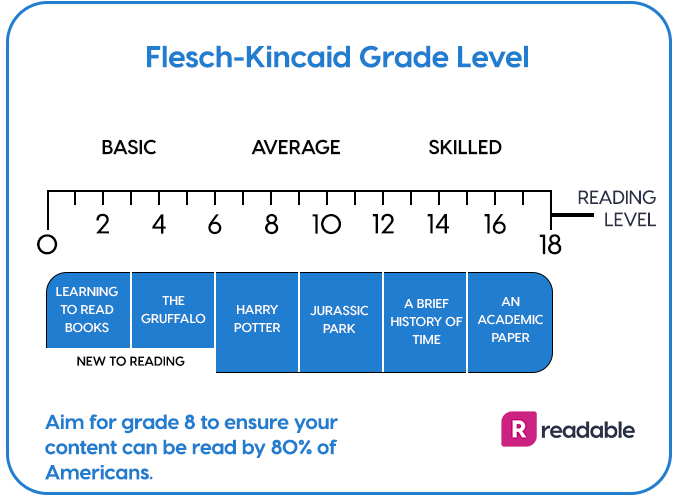

Our free readability formula tool will analyze your text and output the results based on these readability formulas. Our tool will also help you determine the grade level for your text. The Flesch Reading Ease formula will output a number from 0 to 100 - a higher score indicates easier reading. It seems that you read wrongly what is correctly written in the linked page. It states: Use of this scale is so ubiquitous that it is bundled with popular word processing programs and services such as Google Docs, KWord, Pages Lotus, Microsoft Office Word, WordPerfect, and WordPro.
Thanks for the question!On your Readability level, make sure you do not have the text tagged with
'No Proofing' or a language you don't have installed. If you have, you will
disable all the proofing tools including the readability count.

Send me a copy of that document if you like, and I will see if I can find
the problem for you.
Some MVPs (me, for example...) refer to the 'Forum' as 'The Electronic
Headless Chicken' because its behaviour is at times indistinguishable from a
chicken whose head has just been cut off.
Those who did not grow up on a farm may not realise that your average
serving of KFC began as a hen, and that if you cut the head off a live
chicken, the body will often run around in a random pattern for several
seconds. Eeeewww....
The forum is supposed to replicate posts out to the NNTP server where most
of the helpers are working. If you add to an existing thread, the forum
should replicate the whole thread out so we can get the context. It doesn't
usually work.
We recommend alternatives here:
http://word.mvps.org/Mac/AccessNewsgroups.html
Hope this helps
On 16/08/09 9:45 AM, in article 59b6bdad.4@webcrossing.caR9absDaxw,
'N...@officeformac.com' <N...@officeformac.com> wrote:
This email is my business email -- Please do not email me about forum
matters unless you intend to pay!
--
John McGhie, Microsoft MVP (Word, Mac Word), Consultant Technical Writer,
McGhie Information Engineering Pty Ltd
Sydney, Australia. | Ph: +61 (0)4 1209 1410
+61 4 1209 1410, mailto:jo...@mcghie.name
Jeff Atwood asked What’s Wrong With Apple’s Font Rendering? and as I answered in the comments it comes down to philosophy:
The primary difference is that Microsoft try to align everything to whole pixels vertically and sub-pixels horizontally.
Apple just scale the font naturally – sometimes it fits into whole pixels other times it doesn’t.
This means Windows looks sharper at the expense of not actually being a very accurate representation of the text. The Mac with it’s design/DTP background is a much more accurate representation and scales more naturally than Windows which consequently jumps around a lot vertically.
Jeff and Joel both wrote follow up posts agreeing that it is one of philosophy but both are of the opinion that the Windows pixel-grid approach is the better whilst our displays are only capable of low dots-per-inch (DPI).
What they don’t seem to appreciate is the compromise this causes.
Here is an example of Times New Roman on Windows (left) and Mac OS (right) scaled over whole point sizes with sub-pixel precision:
The two thing to note here arising from this “pixel-grid is king” approach are
- Windows does not scale fonts linearly as the rough line points out
- Windows scales the height and width but not the weight of the font
Neither of these may matter to a casual user but for professionals preparing material destined for high DPI (film or print) then it’s a world of difference. How can you layout a page on-screen and expect the same result on the page when the font isn’t the same width?
The issue is reminiscent of the “I hate black bars on wide-screen films” brigade who believe that the film should be chopped, panned, scaled and otherwise distorted from the artists original intention simply so that it fits better on their display.
Typography has a rich and interesting history developed and honed over centuries. It is a shame to misrepresent typefaces especially as the pixel-grid approach becomes less relevant as displays reach higher resolutions.
Update
Some additional comparisons and a note that the gamma differences between Windows and Mac will affect how you see the “other” systems rendering on your machine.
Further update (21 August 2007)
Thanks to Daring Fireball and ZDNet we’ve had a few more great comments which I’ve summarized here:
George thinks the philosophy idea is wrong because “What percentage of Mac users sit around all day doing nothing but pre-press work?” but as Fred points out Microsoft’s desktop-user optimized rendering ends up on images and videos all over the web, thus escaping the environment for which it was crippled.
George also claims that Vista’s rendering is improved, I can’t vouch for that one way or another but from looking at his screen shots the difference there could simply be the contrast level as adjusted by the ClearType tuner.

Nathaniel believes that it’s not Microsoft’s job to manipulate a typeface and that if you want on-screen readability then choose a font designed for that such as Microsoft’s own Tahoma or Apple’s Lucida Grande.
Microsoft Word Readability Tool
I’d go further and say that Microsoft’s own aggression in sticking to the grid kills font choice at the regular reading size of 10/11 point by optimizing everything to a generic sans or serif look:
Windows XP
Mac OS X
Microsoft Word Readability Checker
James points to an article called Texts Rasterization Exposures that proposes a combination of using vertical hinting only and calculating horizontally to 256 levels and has some convincing screen-shots showing the benefits. Probably too late for Leopard or Vista SP1 though.
[)amien